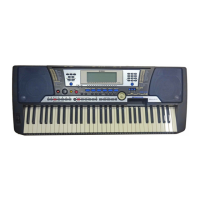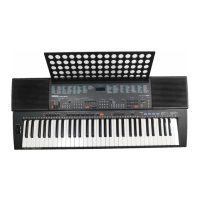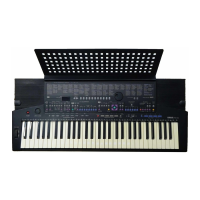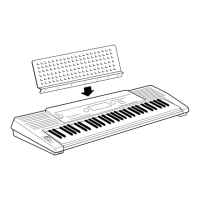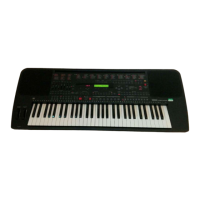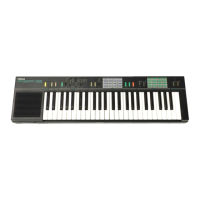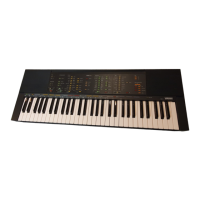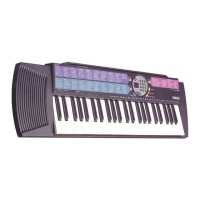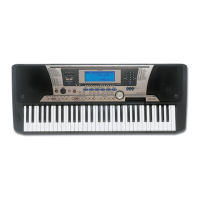
Do you have a question about the Yamaha PortaTone PSR-550 and is the answer not in the manual?
| Type | Portable Keyboard |
|---|---|
| Brand | Yamaha |
| Model | PortaTone PSR-550 |
| Number of Keys | 61 |
| Styles | 100 |
| Preset Styles | 100 |
| Display | LCD |
| Sequencer | Yes |
| MIDI | Yes |
| Speakers | Yes |
| Power Consumption | 18W |
| Effects | Reverb, Chorus, DSP |
| Polyphony | 32 |
| Amplifier | 6W + 6W |
| Connections | Headphones, Sustain Pedal, MIDI In/Out |
| Power Supply | AC Adaptor |
| ROM | Unknown |
Information regarding specifications is subject to change without prior notice.
Service charges for user-knowledge related issues are the owner's responsibility.
Information on environmental friendliness and battery handling precautions.
Details on where to find the product's name plate for identification.
Essential safety guidelines to prevent injury and product damage.
Recommendations for backing up important data and storage practices.
Instructions for initial setup and preparation before playing.
Overview of the PSR-550's key features and functions.
Guide to fundamental operating conventions and controls.
Explanation of all buttons, switches, and connection terminals.
Description of icons and information shown on the LCD display.
Hierarchical structure of functions for easy navigation.
Chart showing functions accessible via Direct Access.
Reference lists including voices, styles, and effects.
Solutions for common problems and operational issues.
Overview of the keyboard's ease of use and intuitive controls.
Information about the built-in songs and audio performance.
Details on keyboard features like touch response and voice layering.
Explanation of the auto accompaniment feature and its 112 styles.
Convenient way to select style, voice, and effect settings.
Using pre-recorded rhythmic and melodic phrases for performance.
Saving and recalling panel settings for instant performance setups.
Features for recording and editing your own keyboard performances.
Adding ambiance and depth with reverb, chorus, and DSP effects.
Saving and loading user data like songs, styles, and registration memory.
Expanding musical possibilities via MIDI connectivity.
Explanation of logos indicating supported standards and features.
Information on attaching and using the included music stand.
Connecting a footswitch for sustain or other functions.
Connecting headphones for private practice.
Detailed listing of all controls on the top panel.
Listing of all controls and terminals on the rear panel.
Provides instructions for connecting AC adapter or batteries for power.
Details the parameters and settings stored within the Music Database.
Instructions on how to access various function displays.
Guide to understanding menu messages and navigator prompts.
Steps for selecting items within menus.
How to adjust numeric values for settings and parameters.
Procedure for naming user data like songs and styles.
Instantly accessing specific displays using the Direct Access button.
Overview of functions accessible via the FUNCTION button.
Accessing the recording functions for songs, styles, and pads.
Accessing the style selection and recording functions.
Accessing the multi pad recording and editing functions.
Using the instrument for playing with auto accompaniment.
Playing back and performing songs.
Recording performances, songs, styles, and multi pads.
Saving, loading, and managing data on floppy disks.
How to choose and play different instrument sounds.
Layering two voices for the right hand.
Assigning different voices to the left and right hands.
Setting the keyboard split point for different voice sections.
Overview of other keyboard functions like naming and split point.
Changing the overall pitch of the instrument.
Using the pitch bend wheel for expressive note bending.
Turning the sustain effect on or off.
Selecting and playing drum kits and percussion sounds.
Playing with only the rhythm tracks of the auto accompaniment.
Playing with all tracks of the auto accompaniment feature.
Utilizing Intro, Main A/B, Fill-in, and Ending sections.
Setting the tempo using the button or tap function.
Selecting fingering modes for chord input.
Defining the split point for the accompaniment section.
Engaging the synchro stop function for accompaniment control.
Instantly setting voices, effects, and styles with one button.
Triggering pre-recorded rhythmic and melodic sequences.
Transposing pad phrases to match played chords.
Choosing from different banks of multi pad phrases.
Enabling or disabling the chord match function for pads.
Reference list of available multi pad banks.
Adding spatial ambiance with various reverb types.
Creating a richer sound by simulating multiple instruments.
Applying special effects like distortion and tremolo.
Adding harmony notes or echo effects to melodies.
Explanation of how system and insertion effects operate.
Saving current panel settings to a memory location.
Instantly loading saved panel settings.
Maintaining accompaniment settings when changing registration.
Choosing a bank to access saved registration settings.
Assigning custom names to registration memory banks.
List of parameters saved in registration memory.
Loading and playing song files from a floppy disk.
Precautions for using floppy disks and the disk drive.
Preparing floppy disks for use with the PSR-550.
Saving user data to a floppy disk.
Loading user data from a floppy disk.
Copying song data between floppy disks or internal memory.
Removing individual files from a floppy disk.
Basic steps to play songs from a disk.
Turning individual tracks on or off during playback.
Adjusting the volume for song playback.
Starting song playback from a specific measure.
Setting a section for repeated playback.
Transposing the pitch of a song.
Changing the voice for individual parts in songs or styles.
Adjusting volume, pan, octave, and effect depth for parts.
Quickly and easily recording keyboard performances.
Recording up to sixteen tracks independently.
Re-recording specific song sections and setting start points.
Aligning recorded notes to a specified timing resolution.
Modifying voice-related parameters for recorded tracks.
Assigning custom names to recorded songs.
Deleting specific tracks or entire songs.
Recording custom phrases to user multi pads.
Configuring chord match for multi pad phrases.
Assigning names to user multi pad banks.
Deleting data from user multi pads.
Editing rhythm track patterns from preset styles.
Recording other tracks besides rhythm.
Recording styles using repeating measure loops.
Adding new material to existing recorded style data.
Aligning recorded style track notes to a specified timing.
Assigning custom names to created styles.
Deleting style data or specific tracks.
Explanation of MIDI, acoustic vs. digital instruments.
Exploring the possibilities of MIDI connectivity.
Information on data compatibility between MIDI devices.
Steps for connecting the PSR-550 to a computer via MIDI.
Configuring transmit/receive settings with templates.
Setting MIDI channels for data transmission.
Setting MIDI channels for data reception.
Controlling internal tone generator from external MIDI.
Selecting internal or external MIDI clock source.
Transmitting current panel settings to external devices.
Using the metronome for timing practice.
Adjusting the overall pitch of the instrument.
Tuning individual notes or selecting scale templates.
Adjusting keyboard response to playing touch.
Automatically setting parameters for individual voices.
Assigning functions to the connected footswitch.
Comprehensive list of all available voices with MIDI details.
List of available drum kits and their note assignments.
Catalog of all built-in auto accompaniment styles.
List of songs and their associated panel setups in the database.
Explanation of how digital effects are applied.
Reference for different harmony and echo effect types.
Solutions for common problems and operational issues.
Procedures for backing up data and resetting to factory settings.
List of messages displayed by the PSR-550.
Technical details on MIDI message structure.
Chart detailing MIDI message transmission and reception.
Details on the keyboard size, touch response, and LCD display.
Information on power, volume, and button controls.
Specifications for voices, polyphony, and voice settings.
Details on styles, accompaniment features, and multi pads.
Specifications for style recording and MIDI connectivity.
Details on digital effects and registration memory features.
Specifications for disk management and song recording.
Information on utility functions and external connections.
Details on audio output, power requirements, and supply.
Physical dimensions, weight, and included/optional accessories.

